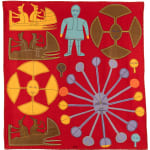-
Artworks
JESSIE OONARK, O.C., R.C.A (1906-1985) QAMANI'TUAQ (BAKER LAKE)
Untitled (Composition with Skidoos and Ulus), c. 1971-72wool duffle, felt, cotton thread and embroidery thread, 53 x 50.75 in (134.6 x 128.9 cm)
signed, "ᐅᓇ".LOT 28
ESTIMATE: $40,000 — $60,000
PRICE REALIZED: $168,000.00
A world record for the artist at auction.Further images
Composition with Skidoos and Ulus is exceptional (and possibly unique) in its blend of imagery. More than in perhaps any other of her important works on cloth, here Oonark has...Composition with Skidoos and Ulus is exceptional (and possibly unique) in its blend of imagery. More than in perhaps any other of her important works on cloth, here Oonark has boldly juxtaposed very traditional and symbolic with very modern images. As Bernadette Driscoll has observed,
The triangular knife with a curved blade and handle, known as the ulu, is recognized across the arctic as the symbol of the woman. Yet no other artist has employed it as consistently as Oonark, raising the implement itself to the level of a graphic and symbolic convention” [1].
Here the ulu shapes radiate from the heads of smiling women. It is one of her most brilliant and visually pleasing inventions. Oonark has incorporated traditional Inuit women’s tattoo imagery as well – brilliantly and charmingly – on the woman’s face at the centre of the radiating circles that likely represent drums or drumbeats. (Can you find the other tattoos?) The modern images are, of course, the three snowmobiles (or skidoos, as they are often called). Oonark’s snowmobiles quite resemble the form of early 1960s Ski-Doo machines. We love the way the handlebars just float in the drivers’ hands! As strikingly modern as skidoos would have been in the early 1970s, visually they don’t seem out of place, perhaps becauseof their similarity to traditional sleds.
Although it has been noted that Oonark depicted modern forms of transportation such as snowmobiles, airplanes, and helicopters, we have not found more than a handful of images in the literature. (It is quite a remarkable coincidence, therefore, that we are offering the c. 1976-78 drawing Transformations in this auction, Lot 128.) Therefore, Composition with Skidoos and Ulus is quite rare in its imagery and certainly ground-breaking. Created possibly as early as late 1971 or in 1972 (it was published in Fall 1972), this work on cloth is contemporaneous with or slightly predates two other important works on cloth with very similar imagery dated to 1972; one features three skidoos, the other four radiating ulus, both are untitled, and one is housed in the Canadian Museum of History collection (see Blodgett and Bouchard, Jessie Oonark, WAG, 1987, cats. 54 and 56; the CMH work is also illustrated in Hessel, Inuit Art, 1988, pl. 138). We have so far not seen Oonark drawings or works on cloth with this imagery made earlier than this date (although unpublished examples may exist).
Composition with Skidoos and Ulus is a brilliantly conceived work on cloth from Oonark’s early mature period. Its relatively large visual elements are beautifully balanced; note that the composition is not arranged in tiers as slightly later works would be. The artist effortlessly fills gaps in the layout with the figure of a man and three charming little drum spirits; as usual, nothing looks out of place. Oonark’s love of colour changes and alternating patterns is much in evidence, in both her choice of felt appliqué and contrasting embroidery floss. Her clever use of embroidery has already been mentioned regarding the gorgeous tattooing in the lower right quadrant, but we would like to point out Oonark has changed up the positions of the skidoo drivers’ legs. We should also mention that this marvelous work on cloth is in pristine condition, its strong, brilliant colours as bright as ever. Fabulous.
1. Driscoll, Arts Manitoba, Fall 1984, p. 16.
References: For important works on cloth by Oonark with similar or related imagery see Ingo Hessel, Inuit Art: An Introduction, (Vancouver: Douglas & McIntyre / New York: Harry Abrams / London: British Museum Press, 1998), pl. 138, p. 170 (depicting three snowmobiles). See also Jean Blodgett and Marie Bouchard, Jessie Oonark: A Retrospective, (Winnipeg: Winnipeg Art Gallery, 1986), cats. 50-51, pp. 118-119, cat. 56, p. 123, and cat. 76b, p. 132 (radiating ulus); and Marion Jackson, Judith Nasby and William Noah, Qamanittuaq: Where the River Widens, (Guelph, ON: Macdonald Stewart Art Centre, 1995), cat. 9 (radiating ulus and “ladle” shapes). For Driscoll's full article, seeBernadette Driscoll, “Tattoos, Hairsticks and Ulus: The Graphic Art of Jessie Oonark,” Arts Manitoba (Fall 1984:12-19). For additional important examples see First Arts, May 28, 2019, Lot 24; and Dec. 1, 2020, Lot 39.
Provenance
Innuit Gallery of Eskimo Art, Toronto;
Purchased from the Above by a Private Collection, Winnipeg, MB.Exhibitions
Toronto, Art Gallery of Ontario, The People Within, 24 June - 4 August 1976, cat. no. 49.Publications
The People Within, (Toronto: Art Gallery of Ontario, 194), cat. no 49, reproduced as a colour plate, unpaginated, as "Untitled, c. 1972-75, Collection of Canadian Arctic Producers, Ottawa, and 53.5 x 53 in [sic]";
The Beaver, Autumn 1972, front cover, to accompany "Wall Hangings from Baker Lake” by Sheila Butler (pp. 26-31), discussed on p. 31.
Join our mailing list
* denotes required fields
We will process the personal data you have supplied in accordance with our privacy policy (available on request). You can unsubscribe or change your preferences at any time by clicking the link in our emails.












